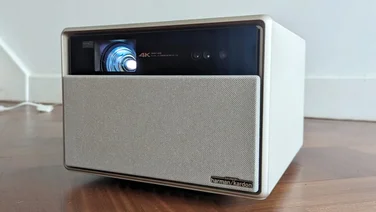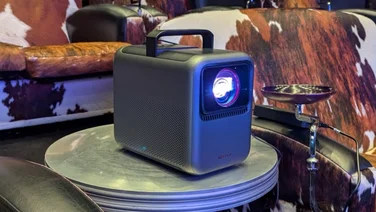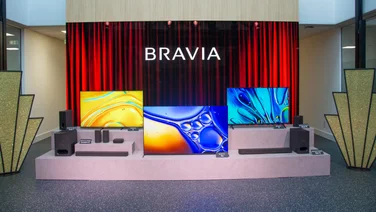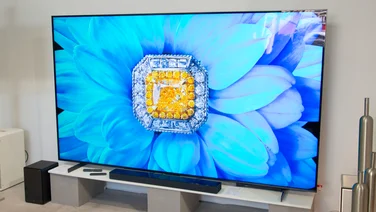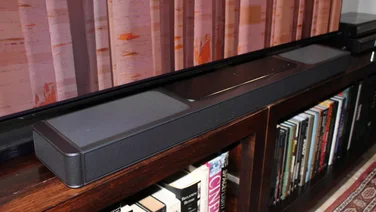To help us provide you with free impartial advice, we may earn a commission if you buy through links on our site. Learn more

- Super-slim design is perfect for wall-mounting
- The usual sublime OLED image quality
- Ready for the latest 120Hz 4K consoles
- Image quality no better than cheaper CX model
- HDR not as bright as rival LCD TVs
Youre probably already asking yourself the same question: if LGs CX OLED already delivers superlative image quality in pretty much every possible situation, what can the GX possibly do better? The clue is in the name. The G stands for Gallery Series and this means that the GX packs all the OLED goodness from the CX into a slimmer body thats purpose built for wall-mounting. In fact, it even comes with a wall mount included in the box. All you need to do is get the drill out.
LG GX OLED: Key specifications | |
| Screen sizes available: | 55in OLED55GX6LA, 65in OLED65GX6LA, 77in OLED77GX6LA |
| Panel type: | OLED |
| Resolution: | 4K/UHD (3,840 x 2,160) |
| Refresh rate: | 120Hz |
| HDR formats: | Dolby Vision, HDR10, HLG |
| Audio enhancement: | Dolby Atmos |
| HDMI inputs: | HDMI 2.1 x 4 |
| Streaming services: | Netflix, Disney Plus, Amazon Prime Video, Now TV, Apple TV, Rakuten TV, YouTube, BBC iPlayer |
| Tuners: | Terrestrial, Cable, Satellite |
| Gaming features: | VRR (G-Sync, FreeSync), ALLM |
| Wireless connectivity: | Wi-Fi 802.11ac |
| Smart platform: | LG WebOS |
LG GX OLED TV review: What you need to know
If youre hoping for a TV that delivers better image quality than the CX, then prepare to be disappointed. With the same panel and same picture processor at the helm, you wouldnt be able to tell them apart. The sole difference is in the design.
If youre not familiar with either of LGs OLED TVs, however, then lets bring you up to speed. The GX takes one of LGs latest OLED panels, pairs it with the mighty Alpha9 Gen3 picture processor and has support for 4K 120Hz input via any of its four HDMI ports. With VRR providing support for both AMD Freesync and Nvidia G-Sync, its a gamers dream. In short, its ready and raring to get any one of its four HDMI ports on one of the forthcoming Microsoft or Sony consoles.
It has pretty much everything youd expect from a top-flight TV in 2020. You get LGs superb WebOS front end which supplies silky smooth access to all the major streaming services, including Netflix, Now TV, Prime Video, Disney+, BBC iPlayer, Rakuten, Youtube and more. Theres also support for hands-free voice control, and you can request Alexa or Google Assistants help, too, if that suits.
HDR support includes HDR 10, HLG and Dolby Vision, so you wont be missing out on any HDR goodness. Notably, the LG sets also feature support for Dolby Vision IQ which dynamically boosts brightness for HDR content depending on the ambient light a real boon for daytime watching.

LG GX OLED TV review: Price and competition
LG GX OLED: Free wall-mount installation and £100 gift card at John Lewis
The price for the 55in model has come down to £1,799, and that now includes free wall-mount installation and a £100 gift card. It's still not going to challenge the LG CX for value, but this deal is a good one all the same.
£1799
John Lewis
The GX might be slim, but bear in mind that its you thats paying for the personal trainer. Whereas the tubbier 55in CX has an RRP of £1,799, the 55in GX pushes the price up to £2,099. That pattern continues as you move up the screen sizes, too. The 65in GX adds £500 for an RRP of £2,999, and the 77in model adds £1,000 to command a mighty RRP of £5,999. Unlike the CX, the GX doesnt come in a smaller 48in version.
In terms of pricing, though, quite a bit has changed since the GX was launched earlier in the year. The CX has dropped down significantly, with the 55in model now doing the rounds at £1,399. The GX hasnt seen such drastic discounts, but it too has dropped to around the £1,799 mark. Thats still markedly more expensive but bear in mind that youre getting a wall mount included in the price. And with retailers such as John Lewis throwing in free wall mount installation for that £1,799 asking price, it begins to look like an even better deal especially if youre looking for a superb, super-slim wall-mounted television.
If you couldnt give two hoots about wall mounting, though, then its a different story. If you want support for 4K 120Hz, Variable Refresh Rate and all the next-gen console features you could shake a controller at, then the £1,399 55in CX is hard to ignore. If its an OLED you seek, thats the one to beat.
If thats still not bargain enough for you, then keep an eye on the Philips 805 (click here to read our full review). Its only just landed on the shop shelves, so hasnt seen the same discounts yet, but its RRP is much more competitive the 55in model costs only £1,499 and its entirely possible that itll see some aggressive price drops for the impending Black Friday sales. Definitely one to watch.
There is one final word of advice: if you prize the TV that produces the brightest, most dazzling HDR for the money, then youll want to swerve OLED TVs entirely. Theyre the supreme leaders for darker rooms and Dolby Vision IQ as featured in the GX does an excellent job of making HDR more watchable in daytime settings, too but the stars of the LCD TV galaxy simply shine more brightly. Set your sights on something like Samsungs Q95T (click here to read our full review), and you can take home a 55in model for £1,499. That TV produces dazzling HDR even in the brightest of living rooms or sun-drenched conservatories and those are the kind of scenarios in which OLED simply cant hold a candela to LCD.
LCD has one other key advantage: its not susceptible to the screen burn issues which still dog OLED screens. If youre unaware of the phenomenon, screen burn is where static logos, computer desktops or onscreen displays are temporarily or permanently burned into the screen. Leave a static image on an OLED screen long enough, and it will happen the question is how long it takes before the screen burn becomes permanent. Every generation of OLED technology has steadily improved its ability to resist permanent damage indeed, youre highly unlikely to have any issues in everyday use but if you were tempted to use an OLED TV as a giant PC monitor, think twice.

LG GX OLED TV review: Design and features
Its admittedly not something youll do very often with a TV, but look at the GX from the side and youll find that its a slender 23.1mm thick from the top to the bottom. By comparison, peer around the side of the CX and youll notice that its slim at the top but then bulges out at the bottom to a maximum of 46.9mm thick. If youre wanting a TV for almost-flush wall mounting, the GX is the one to pick. Whats more, it doesnt even come with a normal stand in the box: thats an optional extra, and as its metal feet screw onto each end of the TV youll need a very wide AV stand or table to accommodate it. In other words, dont bother.
You get four HDMI 2.1 ports at the rear, all of which support 4K 120Hz inputs, and one acts the eARC channel. There is also a trio of USB 3 ports on the side, and you also get dual-band 802.11ac Wi-Fi and Bluetooth 5. All of the wired inputs and outputs can be routed neatly to emerge at the bottom rear of the TV, and a clip-on panel keeps those wires completely hidden from view to maintain the GXs slim profile.
You wouldnt expect much from internal speakers on a TV this slim, but the GX is something of an outlier. Theres enough clarity and volume to make a surprisingly good fist of movies and TV for everyday use. If you cant upgrade to a soundbar or proper surround sound setup right away, then youll be pleasantly surprised. And if you do want a matching soundbar, it’s well worth considering LG’s own GX soundbar – its slim, wall-mountable design is a perfect match (read our full review here).
Its nice to see Dolby Atmos audio support make the grade, but DTS passthrough has sadly fallen by the wayside. If you want to take advantage of content with DTS audio then you wont be able to stream it via the TVs internal apps nor use the GXs eARC connection as a passthrough; youll need to connect a separate Bluray player or streaming device directly to your AV amplifier and daisy-chain it onwards to the GX. Admittedly, its not going to be a big deal for many people, but its disappointing for enthusiasts or anyone using a soundbar with a single HDMI ARC connection.
The LG Magic Remote doesnt look particularly special but it works really well. If youre coming from an old-school remote thats cluttered with buttons, LGs simple, stripped-down selection is much more accessible. The central directional pad has a neat little scrollwheel in the centre which you can click like a button, or spin to quickly move through menus. The shortcut buttons for Prime Video and Netflix are a welcome touch, too.
Wave the remote at the TV, however, and a red mouse cursor appears on screen: this allows you to use the Magic Remote like a Nintendo Wii controller, and it works really well for quickly scrolling through and selecting onscreen options. It is slightly annoying when said cursor suddenly appears because youve nudged or sat on the remote, though.
You also get voice control thrown in thanks to LGs ThinQ AI, with the microphone button on the remote allowing you to bark orders at theTV. This provides hands-free control of the volume, and lets you switch display modes or launch streaming apps. Google Assistant or Amazon Alexa are on the cards, too, if you choose to enable them.

LG GX OLED review: Image quality
As mentioned earlier, the GX doesnt offer any improvement in image quality over the cheaper CX. Thats not a huge deal, however, as theres not much to improve upon. Indeed, turn on the GX and your first instinct will probably be to sit down and start rewatching every one of your favourite movies; if youre coming from an older LCD set, or an elderly Plasma, the sheer difference in clarity and contrast is staggering. These natural talents combine with super-wide viewing angles, a highly effective anti-glare coating and great picture processing to ensure the GX delivers pristine image quality in most situations.
Straight out of the box, though, the picture settings are not tuned for accuracy: everything looks a little too bright and oversaturated and the turned-up-to-11 processing imbues everything with a floaty, soap-opera effect. If accuracy is more your thing, then switching to either the ISF Bright Room or ISF Dark Room presets immediately dials everything back, producing an impressively colour accurate picture.
That done, youre rewarded with a stunning image. Upscaling is superb, with even Full HD sources looking remarkably close to native 4K content. I sat down to watch a few minutes of Alien: Directors Cut on Blu-ray, and ended up watching it start to finish. OLED is routinely praised for its astonishingly deep black response and contrast and here its truly in its element: the grotty, shadowy corridors of the Nostromo simply ooze with detail.
Its a similar story with HDR content. The GX still lacks the ultimate eye-popping brightness of LCD sets but in all but the brightest living rooms this isnt likely to prove an issue. Peak brightness tops out around 750cd/m2 in HDR and that was more than enough to provide plenty of punch for any of the HDR scenes I tried. Godzilla: King of the Monsters is a dark, gloomy movie that can look awful on lesser TVs, but the GX revelled in the murk. Even with the static metadata of the HDR10 version, it served up oodles of shadow detail, intense HDR highlights and teased out deliciously subtle yet rich hues from the cast of monsters and men.
In numbers terms, the GX knocks it out of the park. The range of colours reproduced by the GX is very similar to the CX, and only differs due to panel-to-panel variance: DCI-P3 coverage is an impressive 99% and Rec2020 is 75%. We tested the most accurate ISF Dark Room and Bright Room modes for SDR content, and both performed brilliantly. The Dark Room preset was marginally the more accurate of the two, delivering an impressively low average Delta E of 1.02 and a maximum deviation of 3.14 this was due to yellow tones being almost imperceptibly out of whack.
Bear in mind that brightness peaks at a low 178cd/m2 in Dark Room mode, though, so it really is best suited to more dimly lit rooms. If you want to leave all the lights on, youll need to swap to the Bright Room mode (which bumps brightness up to 222cd/m2) or increase the Peak Brightness setting to High.

LG GX OLED review: HDR and gaming
HDR content tells a similar story. Youll get eye-searing impact and brightness from the LGs HDR Vivid mode but it isnt strictly accurate its just the brightest of the bunch. For out and out accuracy, youll want to opt for the Cinema preset for all HDR content. This lowers the peak brightness, though, so you may want to enable the Dynamic Tone Mapping option to get a bit more punch or resort to the Vivid mode for the brightest rooms.
Dolby Vision content gets a nice brightness boost from the Cinema Home preset, though, and this is brilliant for daytime HDR viewing it uses Dolby Vision IQ to dynamically adjust the overall picture brightness to suit the lighting conditions.
With those four HDMI 2.1 ports providing all the ALLM (Auto Low Latency Mode), VRR (Variable Refresh Rate) and 4k 120Hz loveliness that a gamer could ask for, the GX is just as desirable as the CX for console-based entertainment. Its ready and raring for the next-gen consoles to arrive.
We didnt test the GX for input lag, principally because its technically identical to the CX. In these tests, the CX delivered ultra-low input lag of 13ms in Full HD 60Hz modes, and 6ms at 120Hz. With VRR enabled, weve seen sites such as Rtings.com reporting figures dipping beneath 6ms even at 4K resolution. The only downside here is that LG has had to turn off virtually all the picture processing to achieve these figures but thats a compromise worth making for all-but-imperceptible amounts of input lag.
LG GX OLED review: Verdict
With the same stupendous image quality that made the LG CX so attractive squeezed into a slimmer frame, the LG GX wont appeal to everyone. That said, once you consider the wall-mount is thrown in for free and the fact that some retailers have been discounting the RRP and throwing in free installation as well its actually not that bad a deal.
Granted, the idea of paying more money for the same performance may seem faintly ludicrous, but the GX makes a convincing argument. If your heart is set on an OLED TV and wall-mounting is essential, its impossible not to recommend the LG GX. It looks great in every way that matters.

